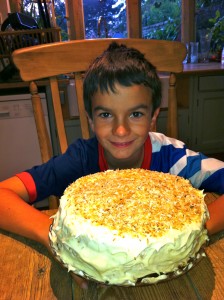While in Normandy, I wanted to check out an area called Mortagne au Perche about an hour west of Paris. This is the region in France from where many of the French

Jordan and Justin posing in front of statue of Zacharie Cloutier created by a local artist
Canadian ancestors emigrated. I was able to find some history on my mother’s side from a french canadian website of baptism records that led me to my 10th great grandfather,
Zacharie Cloutier, who was born in Mortagne au Perche in 1590. Apparently,Zacharie was one of the first french pioneers to “New France” (Canada) in the early 1600′s. I was hoping to find some information about Zacharie while here and, at the very least, see the land from where he came. We booked ourselves a little “gite” cottage in Colonard Corubert about 17 km from Mortagne. It was a bit out of the way, but, it was a very special place. It was called Le Chene, The Oak, because of all the oak trees on the property.

It was so comfortable and reminded me a lot of Grass Valley. The countryside was extremely beautiful. Rolling green hills, oak trees, old stone farms and lots of horses. This is where the beautiful Percheron draft horses come from. We definitely enjoyed the rustic spaciousness of this gite after the little hotel room in Normandy. The boys settled right in and were asking to stay longer than 3 days. There were two dogs, 3 cats, and 3 chickens for them to play with. We had a 3 bedroom, 2 bathroom, 2 story cottage, 16thcentury, on a

hillside with views, horses in pasture across the driveway, a huge lawn area with old orchard fruit trees, and even a tennis court. The owners were English/Scottish and lived on the property. There were 4 old houses on the property, apparently it was a little village in times past, but had been consolidated into one property. I really felt comfortable here and told the boys it was probably because Perche was where our ancestors came from. We would go back to Perche and this cottage in a heartbeat.
Not far from the cottage is an Emigration Museum in the town of Torouvre. This is where the history of the first pioneers to Canada is displayed. The Cloutier name is all over the place. I even found Rue des Cloutiers just down the street. There was so much history here.

Zacharie was a master carpenter in the area and was asked to go to Canada probably because of his skills. Apparently, the name Cloutier means “one who nails.” My grandfather, Ovide Cloutier descends from Zachary’s son Charles. I have all of the Cloutier names through the generations down to my mom. The only thing I was not able to find was the burial place of Zacharie’s parents, Denis Cloutier and Renee Briere. I spoke with the City Hall in Mortagne au Perche and apparently, in those days, the practice was to use the same grave site in the church yard over and over again. So, even though I know that they were supposedlyburied in St. Jean de Baptiste parish, I was not able to find them.

At the museum, we found a write up about Zacharie Cloutier and how he was one of the first immigrants to French Canada.
This has been an interesting journey into my past and I am so happy to have had the chance to visit this area. Zacharie must have been a very courageous and strong person to leave his homeland for a new adventure in the untamed wilderness of Canada. He also must have had a strong sense of family because he did not want to leave them behind, but instead, brought all of them with him on his first trip across. He was very successful in the new land and lived to be 87 years old.












 At Pointe Du Hoc the 250 American rangers had no easy feat either; there were sheer cliffs that they had to summit while Germans were shooting down at them. Once again the Nazis had the higher ground. Although both operations suffered many casualties, they both were successful. These landings eventually led to the retaking of Europe and the defeat of Germany.
At Pointe Du Hoc the 250 American rangers had no easy feat either; there were sheer cliffs that they had to summit while Germans were shooting down at them. Once again the Nazis had the higher ground. Although both operations suffered many casualties, they both were successful. These landings eventually led to the retaking of Europe and the defeat of Germany.

 shelters and weapons, I could see why it took so long for the rangers to capture it.
shelters and weapons, I could see why it took so long for the rangers to capture it.

 Standing on the beach, I thought about how the soldiers must have felt going out there and possibly not coming back. They had great courage. How their families must have felt when they received a telegram about how their son or daughter had died in the war. I also pondered about what these battle fields looked like during the war. Normandy now shows few battle scars. The view one sees when they look over onto the beach makes it is hard to believe that so many people had died there.
Standing on the beach, I thought about how the soldiers must have felt going out there and possibly not coming back. They had great courage. How their families must have felt when they received a telegram about how their son or daughter had died in the war. I also pondered about what these battle fields looked like during the war. Normandy now shows few battle scars. The view one sees when they look over onto the beach makes it is hard to believe that so many people had died there.











